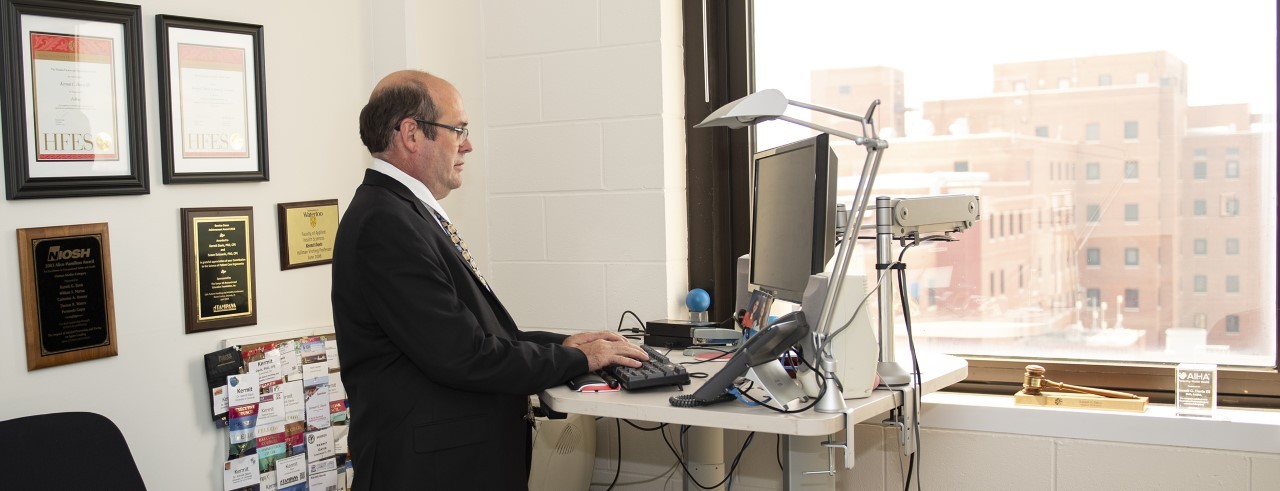
Sit up, raise the screen, pad the chair
UC ergonomics expert says work smarter at home
Taking a few minutes to get that periodic cup of joe might not be such a bad idea.
When working at home, it’s good to have a break, possibly every 30 minutes, to stay healthy and minimize injury to your back, shoulders and arms, says Kermit Davis, PhD, an expert in office ergonomics at the University of Cincinnati College of Medicine.
“The body doesn’t like static postures continually,” says Davis, a professor in the UC Department of Environmental and Public Health Sciences. “You don’t want to do all sitting or all standing all the time. You want to alter your position and change it up throughout the day.”
Workers across the nation have converted their basements, spare rooms, dining room tables or bedrooms into makeshift offices in the midst of the coronavirus pandemic. But few have much guidance when it comes to making these new spaces ergonomically safe, says Davis, who runs both UC’s graduate industrial hygiene and occupational ergonomics programs.
“You can go home but you aren’t allowed to take the monitor, chair and most office equipment,” explains Davis. “You can use your laptop from home, but it is designed to be a short-term option. It should be used for a few hours while traveling. It is not meant to be used for eight or nine hours each day.”
The screen and keyboard on laptops are smaller than a standard office computer, says Davis. As a result the user oftentimes looks downward since the smaller screen is well below eye height.
Davis conducted an ergonomic assessment of employees at the University of Cincinnati sending out an email survey to 4,500 faculty and staff after the coronavirus pandemic prompted the university to join many other employers across the nation in sending workers home to continue operations. The survey had 843 people complete it. As part of the study, 41 employees sent Davis photos of workers at home workstations for ergonomic review. This subset showed some trends and offered a glimpse into what many who work from home are encountering.
The survey’s findings were recently published in the scholarly journal Ergonomics in Design.

Kermit Davis, PhD, is a professor in the UC College of Medicine. Photo by Colleen Kelley/UC Creative +Brand.
Davis says the ergonomic evaluations of the home workstations identified many issues that could be adversely affecting the workers. Many chairs were the wrong height with about 41% too low and 2% too high. Fifty-three percent of workers had armrests on their chairs, but 32% did not use them and for 18% of workers the armrests were improperly adjusted, the study found.
Davis says not using the armrests causes contact stress on forearms when rested on the hard front edge of work surfaces and strain across the upper back as the arms need support. Also, support of the back of the chair was not used by 69% and often without any lumbar support for 73% of survey participants. That meant many individuals did not have proper support of their lower back, maintaining the lumbar curvature.
The position of a computer monitor was often too low or off to the side. Three quarters of monitors were laptops, which were too low relative to the workers’ eye height, the study found.
External monitors were also routinely set up too low in 52% of participants or too high in 4%. Another common issue with the monitors was the lack of the primary screens centered in front of the workers occurring in 31% of workers and resulting in twisting of the neck and/or back to view the monitor, according to the study.
Davis says not everyone can spend hundreds of dollars on a new chair or other equipment when working from home. He says there are some cheap and easy fixes that will go a long way in improving the ergonomic well-being of office workers.
Here are a few tips that might be helpful for the homebound office worker:
- Place a pillow on your seat to elevate the seat height.
- Place a pillow or rolled up towel behind your back to provide lumbar and back support.
- Wrap armrests when they are low and not adjustable.
- Move your chair closer to the desk or table to encourage having the back against the back of the seat.
- If a laptop is too low, place a lap desk or large pillow under the laptop to raise the monitor when using it on the lap.
- Use an external keyboard and mouse, along with raising the laptop monitor by placing a stack of books or a box under the laptop when using a laptop on a desk.
- An appropriate standing workstation should have the top of the monitor at eye height and directly in front, keyboard at a height so that forearms are parallel to the ground (approximately 90° elbow angle), and a soft or rounded front edge to the working surface.
- If obtaining a new chair or identifying an appropriate sitting workstation at home is not possible, rotating between a poor sitting workstation and a standing workstation would be the next best practice. There are many simple, makeshift standing workstations available in the home, including implementing the use of an ironing board, a kitchen counter, the top of a piano, a clothes basket placed upside down on a table or desk or a large box under the laptop.
Davis says he worries that workers’ discomfort levels are increasing after more than five months of working remotely. “It’s not just ergonomics changing but also other factors: isolation, teamwork changes and work-life balance is distorted and changes in the stress level that people have,” he says.
Other co-authors in this study include Susan E. Kotowski, PhD, associate professor in the UC College of Allied Health Sciences; Denise Daniel, who is in the first-year master’s degree program of occupational health nursing at the University of Cincinnati College of Nursing; Thomas Gerding, who is pursuing a PhD in environmental and industrial hygiene; and Jennifer Naylor, who is in the master’s degree program of occupational health nursing. Megan Syck is also a co-author and pursuing a Master of Science degree in environmental and industrial hygiene.
Featured image of Kermit Davis, PhD, was taken by Colleen Kelley/UC Creative +Brand.
Next Lives Here
The University of Cincinnati is classified as a Research 1 institution by the Carnegie Commission and is ranked in the National Science Foundation's Top-35 public research universities. UC's graduate students and faculty investigate problems and innovate solutions with real-world impact. Next Lives Here.
Related Stories
Doctors prepare for surgeries with 3D-printed organs
April 11, 2025
Meteora3D, a Venture Lab-backed startup, helps surgeons better understand upcoming procedures by designing and developing quick-to-produce, 3D-printed anatomical models.
A 'night on the Serengeti' — in Cincinnati
Event: April 12, 2025 6:30 PM
University of Cincinnati and Village Life Outreach Project celebrate two decades of service to communities in rural Tanzania. The milestone will be honored on April 12 with a vibrant fundraiser titled “Village Life: Night on the Serengeti,” hosted at Cincinnati’s contemporary 21c Museum Hotel. The evening promises Tanzanian cuisine, art, live performance and, most importantly, a renewed call to sustain a mission that has transformed lives across continents.
President Pinto announces interim provost
April 8, 2025
UC President Neville Pinto announced that Dr. John Weidner, dean of the College of Engineering and Applied Science, will step in as interim provost following Dr. Kristi Nelson's departure on June 1.
